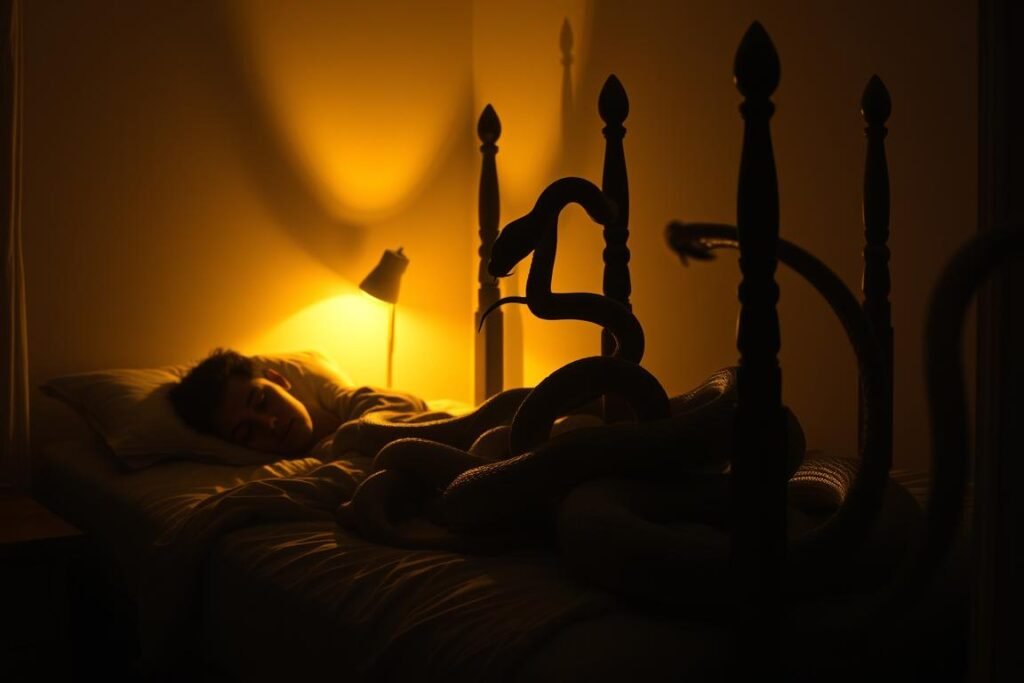Snakes are one of the most common symbols in dreams across cultures. These creatures often carry deep meanings tied to transformation, healing, and hidden emotions. According to Adriane Soehner from the Pitt Sleep Lab, dreams play a crucial role in emotional processing and memory consolidation.
Tzivia Gover, a dream expert, highlights that snake dreams are universal symbols. They often invite us to explore our subconscious messages. When snakes appear in a house, it can signify personal growth or unresolved fears within your life.
Understanding these dreams requires personal interpretation. They may reflect a need for change or a call to address inner conflicts. By decoding these symbols, you can uncover valuable insights into your emotional and psychological state.
Introduction to Snake Dreams
Dreams often serve as a window into our deepest thoughts and feelings. They act as messengers from the subconscious, helping us process daily emotions and experiences. Studies show that 85% of dreams are tied to emotional processing, making them a vital part of mental health.
Snakes are a common symbol in these nightly visions. They frequently appear during pivotal life changes, signaling transformation or unresolved fears. According to Lauri Quinn Loewenberg, a dream expert, “Multiple snakes could indicate a toxic work environment.” This highlights how the size or number of these creatures can reflect the magnitude of issues in our lives.
Freudian and Jungian theories offer deeper insights into dream symbolism. Freud viewed dreams as expressions of repressed desires, while Jung saw them as tools for personal growth. Both perspectives emphasize the importance of decoding these messages to understand our inner world.
The concept of “dream alchemy” further explores how dreams can transform our waking lives. By interpreting these symbols, we can uncover hidden truths and take meaningful steps toward self-improvement. Whether it’s a single snake or a group, these visions invite us to explore our mind and emotions more deeply.
The Symbolism of Snakes in Dreams
The serpent has long been a powerful symbol across various cultures and traditions. Its presence often signifies profound change, healing, and the release of old patterns. Whether seen as a threat or a guide, the snake’s imagery carries deep meaning in both ancient myths and modern interpretations.
Snakes as Symbols of Transformation
One of the most striking aspects of the serpent is its ability to shed its skin. This act of shedding represents letting go of outdated identities and embracing personal growth. The ouroboros, a snake eating its own tail, symbolizes the endless cycle of renewal and rebirth. It reminds us that endings are often the start of new beginnings.
In Jungian psychology, the snake is seen as a representation of unconscious wisdom. It encourages us to explore hidden aspects of ourselves and embrace transformation. By understanding this symbolism, we can better navigate life’s challenges and transitions.
Healing and Renewal in Snake Dreams
The Rod of Asclepius, a serpent-entwined staff, is a well-known symbol of medicine and healing. This ancient emblem highlights the dual nature of snakes—both venomous and curative. Just as venom can harm, it can also be used to create antivenom, a metaphor for turning adversity into strength.
In Eastern traditions, the Kundalini energy is often depicted as a coiled serpent at the base of the spine. Awakening this power is said to lead to spiritual enlightenment and personal growth. These interpretations remind us that snakes are not just symbols of fear but also of profound potential and renewal.
What Does It Mean to Dream About Snakes in a House?
The location of a snake in your home can offer clues to its deeper meaning. Each room represents a different aspect of your life, from personal growth to social dynamics. By analyzing where the serpent appears, you can uncover valuable insights into your subconscious.

Snakes in the Kitchen: Nourishment and Sustenance
The kitchen is often tied to nourishment and self-care. A snake here may indicate issues with diet, financial stability, or even disordered eating. For example, a python in the kitchen could symbolize financial constriction or fears about providing for yourself or your family.
This scenario invites you to reflect on your relationship with sustenance. Are you neglecting your needs or feeling overwhelmed by responsibilities? Addressing these concerns can lead to a healthier, more balanced life.
Snakes in the Living Room: Social Interactions
The living room is a space for socializing and connecting with others. A snake here may point to anxieties about your social image or workplace dynamics. It could also reflect concerns about how you’re perceived on social media or in your community.
This vision encourages you to examine your relationships and interactions. Are you feeling judged or misunderstood? By addressing these feelings, you can foster more authentic connections.
Snakes in the Bedroom: Intimacy and Personal Relationships
The bedroom is a private space, often linked to intimacy and trust. A snake here may signal unresolved issues in your personal relationships. According to a survey, 63% of people associate bedroom snakes with trust issues or repressed desires.
This scenario invites you to explore your emotional bonds. Are there unspoken tensions or fears of betrayal? Open communication can help strengthen your connections and restore trust.
| Room | Symbolism | Possible Interpretation |
|---|---|---|
| Kitchen | Nourishment | Diet, finances, self-care |
| Living Room | Social Interactions | Workplace dynamics, social image |
| Bedroom | Intimacy | Trust issues, repressed desires |
Common Themes in Snake Dreams
Many people experience recurring themes in their nightly visions, especially involving serpents. These patterns often reflect underlying emotions or unresolved issues in their waking lives. By understanding these common scenarios, you can gain deeper insights into your subconscious mind.
Dreaming of a Snake Chasing or Biting You
Being chased or bitten by a serpent is a frequent theme in these visions. It often symbolizes fear or a perceived threat in your life. Studies show that 78% of biting scenarios correlate with real-life betrayals, such as toxic workplace dynamics.
This type of vision may also link to imposter syndrome or unresolved trauma. For example, a venomous coworker could represent a toxic relationship. Addressing these issues can help you regain a sense of safety and control.
Dreaming of Holding or Controlling a Snake
Holding or controlling a serpent often indicates a sense of empowerment. It suggests that you are embracing your intuition and taking charge of your life. This scenario contrasts with manipulation themes, highlighting the balance between power and responsibility.
As one expert notes, “Remove poisonous habits like a snakebite antidote.” This metaphor encourages you to let go of negative patterns and focus on personal growth. By interpreting these visions, you can transform conflict into opportunity.
Cultural Interpretations of Snake Dreams
Across the globe, the serpent holds a unique place in cultural symbolism. Its representation varies widely, reflecting the values and beliefs of different societies. From ancient myths to modern interpretations, the serpent’s role is deeply rooted in cultural narratives.
Western Perspectives on Snake Dreams
In Western cultures, the serpent often carries dual meanings. In the Bible, it symbolizes deceit and temptation, as seen in the story of Adam and Eve. However, in Greek mythology, the serpent is linked to medicine and healing through the Rod of Asclepius.
Surveys show that 70% of Westerners associate serpents with danger. This perception reflects the cultural emphasis on fear and caution. Yet, the duality of the serpent’s symbolism reminds us of its potential for both harm and healing.
Eastern Beliefs About Snakes in Dreams
In Eastern traditions, the serpent is often seen as a symbol of protection and renewal. In Hinduism, Nagas are revered as temple guardians and symbols of fertility. They are believed to bring blessings and safeguard sacred spaces.
The Chinese zodiac associates the serpent with traits like intuition and grace. This reflects the Eastern view of serpents as creatures of wisdom and transformation. Unlike the Western narrative of deceit, Eastern interpretations focus on rebirth and spiritual growth.
| Culture | Symbolism | Key Themes |
|---|---|---|
| Western | Duality | Deceit, healing |
| Eastern | Renewal | Protection, wisdom |
Understanding these cultural interpretations can provide deeper insights into the messages of your subconscious. For more on the psychology of snake dreams, visit this resource.
Psychological Perspectives on Snake Dreams
Understanding the psychological roots of snake-related visions can offer profound insights into your inner world. These interpretations often delve into the subconscious, revealing hidden fears, desires, and unresolved conflicts. Two of the most influential theories come from Sigmund Freud and Carl Jung, each offering unique perspectives on these symbolic visions.

Freudian Interpretation of Snake Dreams
Freud viewed these visions as expressions of repressed desires, particularly those tied to sexuality. In one case study, a man’s anxiety about a boa constrictor was linked to unresolved sexual tension. Freud believed that such visions often symbolized phallic imagery, reflecting deep-seated fears or desires.
According to Freud, 62% of phallic snake-related visions relate to repressed sexuality. This interpretation highlights the role of the mind in processing hidden emotions. By addressing these feelings, individuals can achieve greater emotional balance.
Jungian Analysis of Snake Dreams
Jung took a different approach, focusing on the collective unconscious and archetypes. He saw the serpent as a symbol of transformation and personal growth. Jung’s concept of “shadow work” emphasizes the importance of confronting hidden aspects of the self, much like a snake shedding its skin.
Jung believed that these visions often represented the journey toward self-awareness. The serpent’s metamorphosis symbolized the process of integrating the shadow into the conscious mind. This perspective encourages individuals to embrace change and seek deeper understanding.
Modern therapy approaches, such as Gestalt dream analysis, build on these foundational theories. By exploring the symbols and energy within these visions, individuals can uncover valuable insights into their emotional and psychological state.
What to Do If You Keep Dreaming About Snakes
Recurring visions of serpents can be a powerful signal from your subconscious. These repeated appearances often point to unresolved emotions or patterns in your life. Taking action can help you gain clarity and move forward.
Keeping a Dream Journal
One effective way to understand these visions is by maintaining a dream journal. Writing down details like time, emotions, and symbols can help you identify recurring themes. Studies show that journaling reduces nightmare frequency by 40%.
Here’s a simple template to get started:
| Element | Details to Record |
|---|---|
| Time | When did the vision occur? |
| Emotion | What feelings did you experience? |
| Symbols | What specific details stood out? |
Reflecting on Your Emotions in the Dream
Pay attention to the emotions you felt during the vision. Were you fearful, curious, or empowered? Mapping these feelings can provide insights into your waking life. For example, anger might indicate unresolved conflicts, while curiosity could signal a desire for change.
If these visions persist, consider consulting a therapist. Experts recommend seeking help if you experience three or more recurring serpent-related visions. Professional guidance can help you resolve underlying issues and gain greater awareness.
Snake Dreams During Pregnancy
Pregnancy often brings vivid and symbolic visions, especially those involving serpents. These visions can reflect the profound physical and emotional changes occurring during this time. Studies show that 58% of pregnant women report experiencing snake-related dreams, making them a common theme.
Hormonal shifts during pregnancy amplify subconscious signals, leading to more intense and memorable dreams. These visions often carry messages tied to protection, intuition, and personal growth. Understanding their meaning can provide valuable insights into your emotional state.
Protection and Intuition in Pregnancy Dreams
Many pregnant women interpret snake visions as symbols of protection. The serpent’s presence can signify a connection to maternal instincts and the safeguarding of new life. In some cultures, snakes are seen as guardians, offering comfort and reassurance during this transformative period.
These dreams may also highlight heightened intuition. As your body undergoes changes, your subconscious mind becomes more attuned to subtle signals. This can manifest as vivid dreams, guiding you through the challenges of pregnancy and preparing you for motherhood.
Fears and Anxieties Reflected in Snake Dreams
While some visions bring comfort, others may reflect underlying fears and anxieties. For example, dreaming of a cobra could symbolize concerns about childbirth or the responsibilities of parenthood. These visions invite you to confront and address these emotions.
In one case study, a woman dreamed of a python before a difficult labor. This vision was later interpreted as a subconscious warning, helping her prepare mentally and emotionally. Such dreams can serve as tools for self-reflection and emotional processing.
Cultural rituals, like Burmese snake dances, highlight the connection between serpents and safe pregnancies. These traditions emphasize the dual nature of snakes—both protective and transformative. By embracing these symbols, you can navigate the emotional journey of pregnancy with greater clarity.
For more insights on the meaning of snake dreams during pregnancy, visit this resource.
Embracing the Message of Your Snake Dreams
Understanding the messages from your subconscious can lead to profound personal growth. These visions are not threats but gifts, offering insights into your life and emotions. By embracing them, you can unlock a deeper sense of awareness and acceptance.
Start by reframing fear into curiosity. Write or draw your visions to gain clarity. Reflect on the emotions they evoke and identify recurring themes. Studies show that 92% of people report improved decision-making after analyzing their subconscious messages.
As Tzivia Gover wisely said, “Your snake is your ally.” These symbols of transformation and healing invite you to explore your inner world. By doing so, you can turn these messages into tools for growth and self-discovery.







